EPDM (ethylene propylene diene monomer) rubber
EPDM rubber is a copolymer of ethylene, propylene and a small amount of the third monomer non-conjugated diene. The international name is: Ethyiene Propyene Diene Methyiene, or EPDM for short. EPDM rubber has excellent UV resistance, weather resistance, heat aging resistance, low temperature resistance, ozone resistance, chemical resistance, water resistance, good electrical insulation and elasticity, and other physical and mechanical properties. These advantages cannot be replaced by many other materials.
1. Weather resistance has the ability to withstand severe cold, heat, dryness and humidity for a long time, and has excellent corrosion resistance against the erosion of snow and water, which can completely extend the service life of doors, windows and curtain walls.
2. Heat aging resistance means that it has strong resistance to hot air aging. It can be used at -40~120℃ for a long time. It can also maintain effective characteristics for a long time at 140~150℃. It can withstand high temperatures of 230~260℃ in a short period of time. It can play a role in urban building outbursts. Delay effect; coupled with the use of a special formula, EPDM rubber has a similar feel from -50°C to 15°C. This production site installation has created high-efficiency results.
3. Because EPDM has excellent ozone resistance, it is also known as "crack-free rubber". It is especially used in various urban buildings with different atmospheric indexes and is completely exposed to the air. It will also show its product superiority.
4. Resistance to ultraviolet radiation provides environmental protection for users of high-rise buildings; it can withstand 60 to 150Kv voltage, and has excellent corona resistance, electric crack resistance, and arc resistance. Low temperature elasticity, the temperature when the tensile capacity reaches 100MPa is -58.8℃.
5. Due to its excellent special mechanical properties, it is often used in the manufacture of aircraft, cars, trains, buses, ships, high and low voltage switch cabinets, glass curtain walls, aluminum alloy thermal insulation window sealing parts and diving products, high-pressure steam soft Pipes, tunnels, viaduct joints and other waterproof parts and other industrial and agricultural sealing parts.
Main special properties and technical parameters
Dense rubber part Sponge rubber part
Applicable temperature -40~140℃ -35~150℃
Hardness 50~80℃ 10~30℃
Tensile hardness (&) ≥10 -
Elongation at break(&) 200~600% 200~400%
Compression set 24 hours 70(≯) 35% 40%
Density 1.2~1.35 0.3~0.8
1. Due to the advantages of the structural characteristics of silicone rubber, it has the ability to maintain good stability within a certain time range and a certain temperature range. Compared to other synthetic counterparts, silicone rubber can withstand ultra-temperature ranges of -101 to 316°C and maintain its stress-strain properties.

2. Other unique properties of this universal elastomer: radiation resistance, minimal impact of disinfection dose; vibration resistance, nearly constant transmission rate and resonance frequency at -50~65°C; better breathability than other polymers Property; dielectric strength 500V·km-1; transmission rate <0.1-15Ω·cm; loosen or maintain adhesion; ablation temperature 4982°C; minimal exhaust after proper combination; convenient for application under food control regulations Food filling; flame retardant properties; colorless and odorless products can be produced; waterproof properties; physiological inertness of five poisons and medical implants.
3. Silicone rubber can be made into products of various colors according to customer needs and artistic requirements.
Overall physical properties Index
Hardness range 10~90
Tensile strength/MPa up to 9.65
Elongation/% 100~1200
Tear strength (DkB)/(kN·m﹣¹) Max. 122
Bashaud elastometer 10~70
Compression permanent deformation 5% (test condition 180oC, 22H)
Temperature range/℃ -101~316
3. TPV/TPE thermoplastic elastomer
Thermoplastic elastomer has the physical and mechanical properties of vulcanized rubber and the processability of soft plastics. It's somewhere between plastic and rubber. In terms of processing, it is a kind of plastic; in terms of properties, it is a kind of rubber. Thermoplastic elastomers have many advantages over thermoset rubbers.
1. The lower density of thermoplastic elastomer (0.9~1.1g/cm3), thus saving costs.
2. Lower compression deformation and excellent bending fatigue resistance.
3. It can be thermally welded to improve assembly flexibility and sealing.
4. The waste materials (escaping burrs, extrusion waste materials) and final waste products generated during the production process can be directly returned for reuse, reducing environmental pollution and expanding resource recycling sources. It is an ideal green and environmentally friendly material.
Post time: Oct-31-2023
